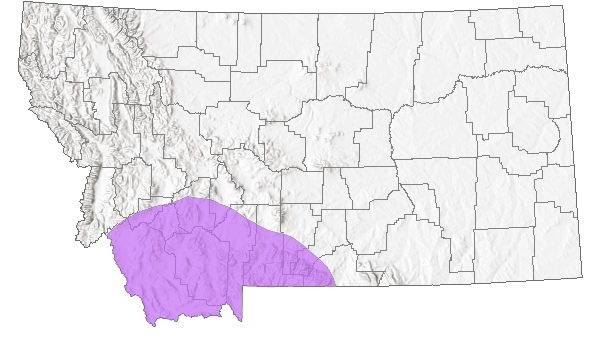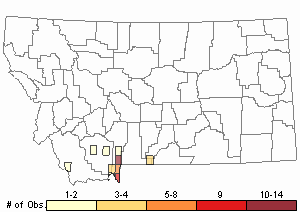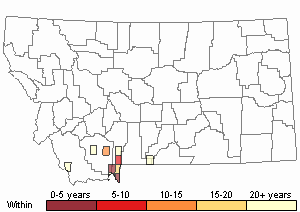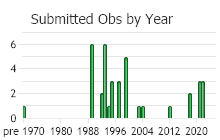View in other NatureServe Network Field Guides
NatureServe
Montana
Utah
Wyoming
Idaho
Wisconsin
British Columbia
South Carolina
Yukon
California
New York
Slender Indian Paintbrush - Castilleja gracillima
Other Names:
Castilleja miniata ssp. miniata
State Rank Reason (see State Rank above)
This plant is a regional endemic, known in Montana from a limited number of populations, with most being relatively small. No threats have been observed, though it could be vulnerable to hydrologic alterations or noxious weeds.
General Description
Slender Indian Paintbrush is a perennial with slender, erect or ascending, usually unbranched stems, 20-50 cm tall, that often root at the base. The entire-margined leaves are narrowly lance-shaped, and the foliage is glabrous or covered with long, soft hairs. The inflorescence is generally yellow, but may be orange or even red. The oblong flower bracts are entire-margined or may have a single pair of small lobes near the top. The calyx is 15-22 mm long and deeply divided into two lobes at the top that are each divided again into two smaller, pointed lobes. The petals of the flower are united into a tube below that forms a large, galea and three small lobes or teeth opposite it. The entire corolla is 20-30 mm long; the galea is densely hairy and less than half as long as the tube, while the lip is green and ca. 1/5 the length of the galea.
Phenology
Flowering occurs from June to August.
Diagnostic Characteristics
Castilleja sulphurea and C. miniata are also perennial species of paintbrush that occur in mid-elevation wetland and riparian habitats. However, both have clumped stems arising from a branched rootcrown and are not rhizomatous.
Dorn (1988, Vascular Plants of Wyoming) considers C. gracillima to be simply a rhizomatous form of C. miniata. Plants similar to C. gracillima occur in southern B.C. and Glacier National Park, Montana (=C. amplifolia) but are referred to C. miniata (Hitchcock et al., 1959, Vascular Plants of the Pacific Northwest, Vol.4).
Species Range
Montana Range
Range Descriptions

 Native
Native
Range Comments
Northwestern WY and adjacent MT to central ID; most BC occurrences are in the Kootenai River Valley contiguous with nothern ID and northwestern MT, yet the species is not present in these sectors of the adjoining states, a peculiarly disjunct distribution that might call for closer taxonomic review.
Observations in Montana Natural Heritage Program Database
Number of Observations: 46
(Click on the following maps and charts to see full sized version)
Map Help and Descriptions
Relative Density

Recency



 (Observations spanning multiple months or years are excluded from time charts)
(Observations spanning multiple months or years are excluded from time charts)
Habitat
Castilleja gracillima occurs on saturated soils along willow-dominated stream courses in sagebrush-grassland settings (Vanderhorst and Heidel 1995). In the Gallatin National Forest, it has been found in wet meadows with at least seasonally saturated soils, along streambanks and on gentle sloping spring terraces (Matthews (1989). Associates include Castilleja minata (scarlet paintbrush), Geranium richardsonii (white geranium), Salix wolfii (Wolf's willow), Epilobium glaberrimum (smooth willow-herb), Habenaria dilatata (white bog-orchid), and Habenaria hyperborea (northern green bog-orchid).
National Vegetation Classification System Groups Associated with this Species
Grassland
Montane - Subalpine Grassland
Wetland and Riparian
Alpine Riparian and Wetland
Riparian Shrubland
Wet Meadow and Marsh
Ecology
Species of the genus
Castilleja are typically hemiparasites, capable of growing with or without deriving supplemental nutrition from a host plant. They are generally pollinated by hummingbirds and insects, and produce many seeds that are very light and easily airborne (Matthews 1989). Species of
Castilleja are subject to herbivory by noctuid larvae, however, slender Indian paintbrush was not observed to be as heavily fed upon as many other species.
Matthews reported populations in the Gallatin National Forest as apparently stable. However, they may be subject to natural disturbance regimes, since cycles of disturbance and re-establishment occur at relatively frequent intervals in the stream and river bank habitats where this species grows.
POLLINATORS The following animal species have been reported as pollinators of this plant species or its genus where their geographic ranges overlap:
Bombus appositus,
Bombus bifarius,
Bombus fervidus,
Bombus flavifrons,
Bombus melanopygus,
Bombus sylvicola,
Bombus occidentalis, and
Bombus kirbiellus (Macior 1974, Thorp et al. 1983, Bauer 1983, Mayer et al. 2000, Wilson et al. 2010, Pyke et al. 2012, Koch et al. 2012, Miller-Struttmann and Galen 2014, Williams et al. 2014).
Management
Recreational fishing is the primary activity where this plant grows in the Gallatin National Forest, and is not thought to affect it (Mathews 1989). Livestock grazing takes place in these drainages, however population monitoring would be needed to detect any impacts.
Stewardship Responsibility
Threats or Limiting Factors
STATE THREAT SCORE REASON
Reported threats to Montana's populations of Slender Indian Paintbrush include the potential threat of trampling from anglers at populations located along the Gallatin River in Yellowstone National Park. (MTNHP Threat Assessment 2021).
References
- Literature Cited AboveLegend:
 View Online Publication
View Online Publication Bauer, P.J. 1983. Bumblebee pollination relationships on the Beartooth Plateau tundra of Southern Montana. American Journal of Botany. 70(1): 134-144.
Bauer, P.J. 1983. Bumblebee pollination relationships on the Beartooth Plateau tundra of Southern Montana. American Journal of Botany. 70(1): 134-144. Koch, J., J. Strange, and P. Williams. 2012. Bumble bees of the western United States. Washington, DC: USDA Forest Service, Pollinator Partnership. 143 p.
Koch, J., J. Strange, and P. Williams. 2012. Bumble bees of the western United States. Washington, DC: USDA Forest Service, Pollinator Partnership. 143 p. Macior, L.M. 1974. Pollination ecology of the Front Range of the Colorado Rocky Mountains. Melanderia 15: 1-59.
Macior, L.M. 1974. Pollination ecology of the Front Range of the Colorado Rocky Mountains. Melanderia 15: 1-59. Mayer, D.F., E.R. Miliczky, B.F. Finnigan, and C.A. Johnson. 2000. The bee fauna (Hymenoptera: Apoidea) of southeastern Washington. Journal of the Entomological Society of British Columbia 97: 25-31.
Mayer, D.F., E.R. Miliczky, B.F. Finnigan, and C.A. Johnson. 2000. The bee fauna (Hymenoptera: Apoidea) of southeastern Washington. Journal of the Entomological Society of British Columbia 97: 25-31. Miller-Struttmann, N.E. and C. Galen. 2014. High-altitude multi-taskers: bumble bee food plant use broadens along an altitudinal productivity gradient. Oecologia 176:1033-1045.
Miller-Struttmann, N.E. and C. Galen. 2014. High-altitude multi-taskers: bumble bee food plant use broadens along an altitudinal productivity gradient. Oecologia 176:1033-1045. MTNHP Threat Assessment. 2021. State Threat Score Assignment and Assessment of Reported Threats from 2006 to 2021 for State-listed Vascular Plants. Botany Program, Montana Natural Heritage Program, Helena, Montana.
MTNHP Threat Assessment. 2021. State Threat Score Assignment and Assessment of Reported Threats from 2006 to 2021 for State-listed Vascular Plants. Botany Program, Montana Natural Heritage Program, Helena, Montana. Pyke, G.H., D.W. Inouye, and J.D. Thomson. 2012. Local geographic distributions of bumble bees near Crested Butte, Colorado: competition and community structure revisited. Environmental Entomology 41(6): 1332-1349.
Pyke, G.H., D.W. Inouye, and J.D. Thomson. 2012. Local geographic distributions of bumble bees near Crested Butte, Colorado: competition and community structure revisited. Environmental Entomology 41(6): 1332-1349. Thorp, R.W., D.S. Horning, and L.L. Dunning. 1983. Bumble bees and cuckoo bumble bees of California (Hymenoptera: Apidae). Bulletin of the California Insect Survey 23:1-79.
Thorp, R.W., D.S. Horning, and L.L. Dunning. 1983. Bumble bees and cuckoo bumble bees of California (Hymenoptera: Apidae). Bulletin of the California Insect Survey 23:1-79. Williams, P., R. Thorp, L. Richardson, and S. Colla. 2014. Bumble Bees of North America. Princeton, NJ: Princeton University Press. 208 p.
Williams, P., R. Thorp, L. Richardson, and S. Colla. 2014. Bumble Bees of North America. Princeton, NJ: Princeton University Press. 208 p. Wilson, J.S., L.E. Wilson, L.D. Loftis, and T. Griswold. 2010. The montane bee fauna of north central Washington, USA, with floral associations. Western North American Naturalist 70(2): 198-207.
Wilson, J.S., L.E. Wilson, L.D. Loftis, and T. Griswold. 2010. The montane bee fauna of north central Washington, USA, with floral associations. Western North American Naturalist 70(2): 198-207.
- Additional ReferencesLegend:
 View Online Publication
View Online Publication
Do you know of a citation we're missing? Culver, D.R. 1994. Floristic analysis of the Centennial Region, Montana. M.Sc. Thesis. Montana State University, Bozeman. 199 pp.
Culver, D.R. 1994. Floristic analysis of the Centennial Region, Montana. M.Sc. Thesis. Montana State University, Bozeman. 199 pp. Dorn, R.D. 1988. Vascular Plants of Wyoming. Mountain West Publ., Cheyenne.
Dorn, R.D. 1988. Vascular Plants of Wyoming. Mountain West Publ., Cheyenne. Hitchcock, C.L., A. Cronquist, M. Ownbey and J.W. Thompson. 1959. Vascular plants of the Pacific Northwest, Part 4. Ericaceae through Campanulaceae. Seattle, WA and London, UK: University of Washington Press. 510 p.
Hitchcock, C.L., A. Cronquist, M. Ownbey and J.W. Thompson. 1959. Vascular plants of the Pacific Northwest, Part 4. Ericaceae through Campanulaceae. Seattle, WA and London, UK: University of Washington Press. 510 p. Lesica, P., M.T. Lavin, and P.F. Stickney. 2012. Manual of Montana Vascular Plants. Fort Worth, TX: BRIT Press. viii + 771 p.
Lesica, P., M.T. Lavin, and P.F. Stickney. 2012. Manual of Montana Vascular Plants. Fort Worth, TX: BRIT Press. viii + 771 p. Lesica, P., M.T. Lavin, and P.F. Stickney. 2022. Manual of Montana Vascular Plants, Second Edition. Fort Worth, TX: BRIT Press. viii + 779 p.
Lesica, P., M.T. Lavin, and P.F. Stickney. 2022. Manual of Montana Vascular Plants, Second Edition. Fort Worth, TX: BRIT Press. viii + 779 p. Mathews, S.Y. 1989. Sensitive plant surveys, 1989: United States Forest Service, Region 1, Gallatin National Forest, Montana. Unpublished report to the USDA Forest Service, Gallatin National Forest, Bozeman, Montana. Montana Natural Heritage Program, Helena, MT. 85 pp.
Mathews, S.Y. 1989. Sensitive plant surveys, 1989: United States Forest Service, Region 1, Gallatin National Forest, Montana. Unpublished report to the USDA Forest Service, Gallatin National Forest, Bozeman, Montana. Montana Natural Heritage Program, Helena, MT. 85 pp. Vanderhorst, J.P. and B.L. Heidel. 1995. Sensitive plant survey in the Tobacco Root Mountains, Madison County, Montana. Unpublished report to the Beaverhead and Deerlodge National Forests. Montana Natural Heritage Program. Helena, MT. 66 pp. plus appendices.
Vanderhorst, J.P. and B.L. Heidel. 1995. Sensitive plant survey in the Tobacco Root Mountains, Madison County, Montana. Unpublished report to the Beaverhead and Deerlodge National Forests. Montana Natural Heritage Program. Helena, MT. 66 pp. plus appendices.
- Web Search Engines for Articles on "Slender Indian Paintbrush"





